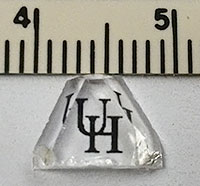Material Absorbs in the Deep-Ultraviolet Wavelengths, has been Produced in Crystal Form
Researchers from the University of Houston’s Department of Chemistry have synthesized a new compound, Ba3(ZnB5O10)PO4, called BZBP for short, with potential applications for use in a deep-ultraviolet solid-state laser.

P. Shiv Halasyamani (center) with researchers Weiguo Zhang (left) and Hongwei Yu
(right) in the crystal-growth facility.Current options for solid-state deep-ultraviolet lasers, which have wavelengths less
than 200 nm, are extremely limited, yet promise to have important industrial applications
if developed. Reports of this new material were published in the journal Advanced Materials.
BZBP Compound: Promising Chemical Properties
“There is only one solid-state compound that can generate wavelengths in the deep-ultraviolet region, which is below 200 nm. This compound, KBe2BO3F2, called KBBF for short, contains beryllium, which is incredibly toxic. Furthermore, no one has been able to grow a crystal of KBBF larger than 4 millimeters,” said P. Shiv Halasyamani, a professor of chemistry in the College of Natural Sciences and Mathematics, and the principal investigator for this paper.
This new compound, BZBP, is free of beryllium and has an absorption edge starting at 180 nm, suggesting that it can be used to produce a laser in the deep-ultraviolet region. In addition to designing and synthesizing this new compound, Halasyamani’s research group worked out the necessary conditions for growing large BZBP crystals, which is an essential step toward use in solid-state lasers.
Industry Evaluating BZBP Crystals
Developing the technique to grow a crystal from a specific chemical compound is a long, risky process that requires patience. With BZBP, Halasyamani’s research group, which includes postdoctoral researcher Hongwei Yu and research associate Weiguo Zhang, figured out the necessary parameters for crystal growth early on.

BZBP crystal grown by Halasyamani’s research group“Creating a crystal is as much of an art as a science. It’s almost like being a chef,
where you have to know when to add the right amount,” Halasyamani said. “I call this
the perfect storm; not only were we able to synthesize this new compound, but we were
able to grow large (centimeter size) crystals at the same time.”
Having a BZBP crystal means that it can be tested for its potential to create a solid-state laser in the deep-ultraviolet region. BZBP crystals are stable at temperatures up to 1000 C and do not react with water, both of which are necessary properties for solid-state lasers.
BZBP is currently being evaluated by a laser company, which will test the crystal’s ability to refract light, as well as its ability to withstand laser damage, essential for use in solid-state lasers.
Current Deep-Ultraviolet Lasers Have Limitations
“What people want is a solid-state laser that goes under 200 nm,” Halasyamani said. “That’s the holy grail.”
Currently, the sub-200 nm laser in widespread industrial use is the excimer laser, which is a gas laser. Excimer lasers are large, with delicate instrument settings. Nevertheless, this is still the best laser available and is widely used in industry to etch computer chips, along with other applications.
“A solid-state laser is easier to use. There’s no tuning, there’s no cooling system required, and it doesn’t break down,” Halasyamani said.
In addition to Halasyamani’s research group, which includes co-authors Yu and Zhang, collaborators included researchers at Northwestern University. This work was funded by the National Science Foundation and the Welch Foundation.
- Rachel Fairbank, College of Natural Sciences and Mathematics